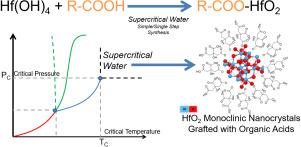Nano-Structures & Nano-Objects Pub Date : 2020-08-26 , DOI: 10.1016/j.nanoso.2020.100540 Saida Mayela García Montes , Seiichi Takami , Motonobu Goto , Rodolfo Morales Ibarra

|
Shape controlled Hafnium oxide nanoparticles were synthesized under supercritical water with and without organic acid surface modifiers to produce grafted nanocrystals. The obtained nanoparticles displayed novel and unique controlled shaped morphologies spherical, semispherical, rod-like cylinders and eruciforms by using either propionic acid, citric acid, 3,4-dihydroxybenzoic acid or gallic acid as demonstrated by transmission electron microscopy. X-ray diffraction analysis showed that monoclinic Hafnium oxide nanocrystals were synthesized in this manner. During the single step synthesis, organic acid molecules directly interact with the nanocrystal surface through carboxylate bonding. Chemical bonding between organic acids and the nanoparticles was evaluated by Fourier transform infrared spectroscopy validating the integrity of the grafted molecules which modify the interaction of the nanoparticles with the media. The grafting density was quantified from the weight loss measured using thermogravimetric analysis, our results show that citric acid and 3,4-dihydroxybenzoic acid have a remarkable interaction accounting for 41.64 % and 100 % respectively of surface coverage of the nanoparticles. The novelty in this experimental research can be emphasized in the unique size and shape control as well as the effective modification of the surface of the Hafnium oxide nanocrystals all of this in a simple single step synthesis under supercritical water.
中文翻译:

超临界水中合成的形状受控的氧化oxide纳米粒子接枝有机酸分子
在具有和不具有有机酸表面改性剂的超临界水中合成形状可控的氧化nanoparticles纳米颗粒,以产生接枝的纳米晶体。如通过透射电子显微镜所证实的,通过使用丙酸,柠檬酸,3,4-二羟基苯甲酸或没食子酸,所获得的纳米颗粒显示出新颖,独特的球形,半球形,棒状圆柱体和椭圆形的受控形状形态。X射线衍射分析表明以这种方式合成了单斜晶Ha氧化物纳米晶体。在单步合成过程中,有机酸分子通过羧酸盐键直接与纳米晶体表面相互作用。通过傅立叶变换红外光谱法评估有机酸与纳米颗粒之间的化学键合,从而验证了修饰了纳米颗粒与介质相互作用的接枝分子的完整性。通过使用热重分析法测定的失重来定量接枝密度,我们的结果表明柠檬酸和3,4-二羟基苯甲酸具有显着的相互作用,分别占纳米颗粒表面覆盖率的41.64%和100%。这项实验研究的新颖性可以通过独特的尺寸和形状控制以及对oxide氧化物纳米晶体表面的有效改性来强调,所有这些都可以在超临界水下通过简单的一步合成完成。通过使用热重分析法测定的失重来定量接枝密度,我们的结果表明柠檬酸和3,4-二羟基苯甲酸具有显着的相互作用,分别占纳米颗粒表面覆盖率的41.64%和100%。这项实验研究的新颖性可以通过独特的尺寸和形状控制以及对oxide氧化物纳米晶体表面的有效改性来强调,所有这些都可以在超临界水下通过简单的一步合成完成。通过使用热重分析法测定的失重来定量接枝密度,我们的结果表明柠檬酸和3,4-二羟基苯甲酸具有显着的相互作用,分别占纳米颗粒表面覆盖率的41.64%和100%。这项实验研究的新颖性可以通过独特的尺寸和形状控制以及对oxide氧化物纳米晶体表面的有效改性来强调,所有这些都可以在超临界水下通过简单的一步合成完成。











































 京公网安备 11010802027423号
京公网安备 11010802027423号